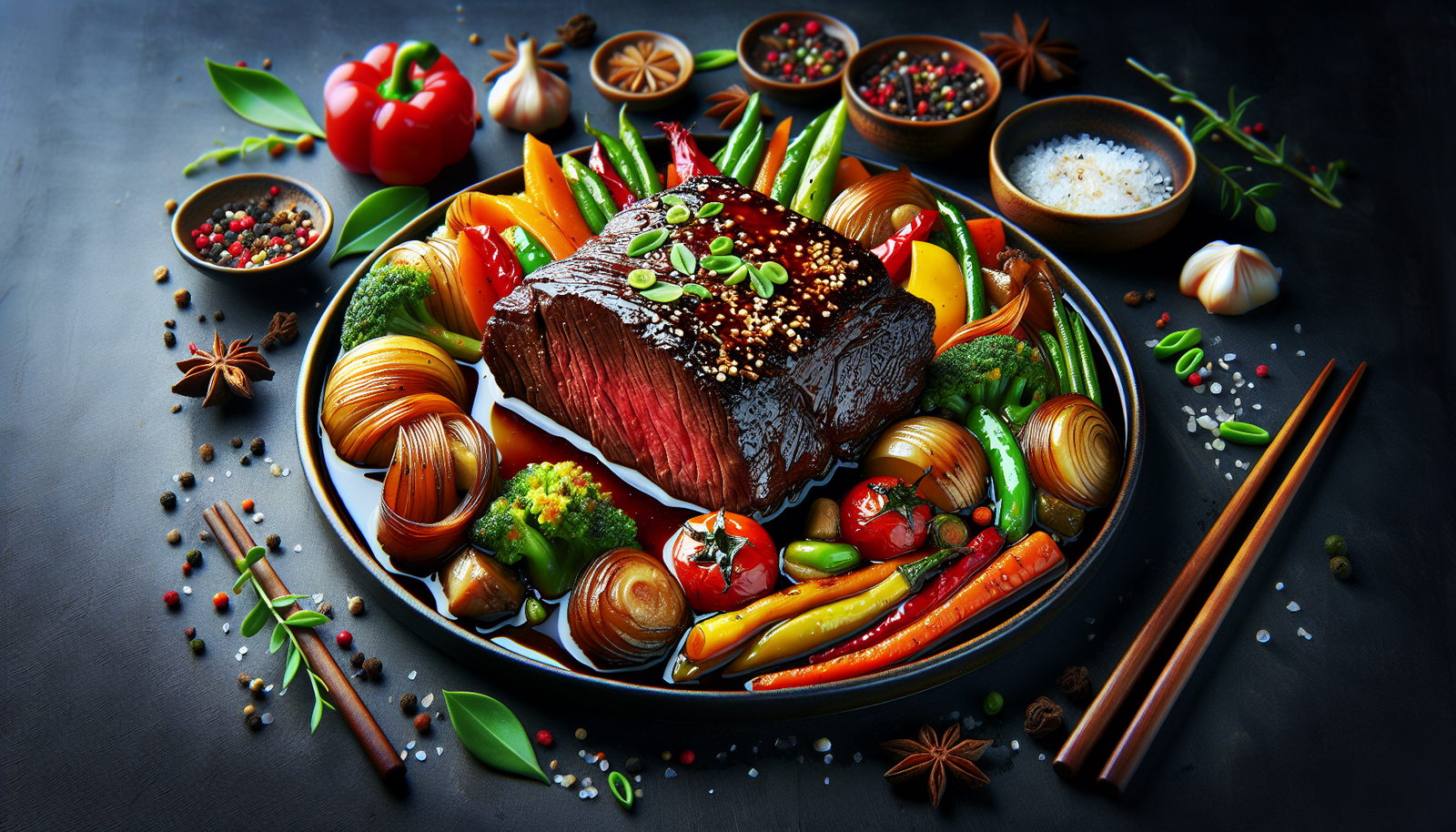I recently stumbled upon an incredible recipe that has quickly become a favorite in my household – Asian pot roast from Tony’s Kitchen. This mouthwatering dish combines tender, slow-cooked beef with a flavorful blend of Asian-inspired ingredients. With each bite, you are transported to a culinary paradise, where the savory aromas and rich flavors of soy sauce, ginger, and garlic dance on your taste buds. The Asian pot roast is a harmonious symphony of flavors that will leave you craving for more.
Asian Pot Roast – A Fusion Delight
As someone who loves exploring different cuisines, Asian pot roast has become one of my favorite dishes to cook. The combination of tender meat, flavorful marinades, and a medley of vegetables creates a fusion delight that never fails to impress. In this article, I will share with you the secrets to creating a delicious Asian pot roast right in your own kitchen.
Ingredients
To prepare this mouthwatering dish, you’ll need a few key ingredients: meat, Asian marinade, vegetables, and seasonings. Let’s take a closer look at each component:
Meat
The choice of meat plays a crucial role in the success of your pot roast. While traditional pot roast often uses beef, Asian pot roast allows for more flexibility. You can opt for beef cuts such as chuck roast or brisket, or venture into other options like pork shoulder or even chicken thighs for a lighter variation.
Asian Marinade
The marinade is the secret behind the bold flavors of Asian pot roast. Combining ingredients like soy sauce, ginger, garlic, sesame oil, and a touch of sweetness from honey or brown sugar, the marinade infuses the meat with an irresistible Asian flair. Feel free to experiment with different combinations of ingredients to create your own unique flavor profile.
Vegetables
No pot roast is complete without an assortment of vegetables. Traditional choices include carrots, potatoes, and onions, but don’t be afraid to get creative. Bok choy, bell peppers, mushrooms, and snow peas are excellent additions that bring a vibrant mix of colors and textures to your dish.
Seasonings
Apart from the marinade, seasonings like salt, pepper, and herbs are essential for enhancing the flavors of your pot roast. Consider adding a bay leaf, thyme, or star anise for an aromatic twist.
Preparation
Now that we have all the ingredients ready, let’s dive into the preparation process. Follow these steps for a delicious Asian pot roast:
Marinade the Meat
Begin by marinating the meat in the Asian marinade. This step allows the flavors to penetrate the protein and tenderize it. Depending on your preference, you can marinate the meat for a few hours or overnight in the refrigerator for maximum flavor infusion.
Sear the Meat
Once the meat is marinated, it’s time to sear it for a beautiful caramelized crust. Heat a large, oven-safe pot or Dutch oven over medium-high heat and add a little oil. Sear the meat on all sides until browned, creating a savory layer of flavor.
Add Vegetables and Seasonings
After searing the meat, add in your chosen vegetables and seasonings. Stir them around to coat them in the flavorful juices from the meat and marinade. This step not only adds depth to the overall taste but also allows the vegetables to absorb the savory goodness.
Slow Cook the Pot Roast
Cover the pot and transfer it to a preheated oven, set at a low temperature, around 300°F (150°C). Let the pot roast slowly cook for several hours until the meat becomes tender and the flavors meld together. The long, slow cooking process ensures a tender, melt-in-your-mouth pot roast that will leave everyone craving for more.
Serving Suggestions
Now that your Asian pot roast is ready, it’s time to serve it up! Here are some serving suggestions to make the most of this delectable dish:
Rice or Noodles
Asian pot roast pairs beautifully with steamed rice or noodles. The fluffy texture of rice or the chewiness of noodles is the perfect canvas to soak up the flavorful sauce and complement the meat and vegetables.
Garnish with Fresh Herbs
Adding a touch of freshness to your pot roast is as simple as garnishing it with fresh herbs. Cilantro, green onions, or Thai basil are excellent choices that provide a burst of vibrant flavors and visually enhance the dish.
Serve with Steamed Vegetables
To complete your meal, serve your Asian pot roast alongside a side of steamed vegetables. Broccoli, snap peas, or baby bok choy are great options that add a delightful crunch and balance out the richness of the pot roast.
Variations
While the classic Asian pot roast recipe is already divine, there’s always room for experimentation and personalization. Here are a few variations you can try:
Substitute Meats
While beef is the go-to choice for pot roast, branching out to other meats can provide exciting alternatives. Try using pork or chicken for a different flavor profile. For a seafood twist, consider using shrimp or fish fillets.
Different Marinades
The marinade is where you can truly get creative. Experiment with different combinations of spices, sauces, and herbs to create your own signature marinade. Incorporate ingredients like lemongrass, soy sauce, hoisin sauce, or even a dash of sriracha for an extra kick.
Vegetarian Options
If you prefer a vegetarian version of pot roast, you can replace the meat with hearty vegetables like portobello mushrooms, eggplant, or tofu. Marinate the vegetables and follow the same cooking process to achieve a satisfying meatless meal.
Tips
To ensure your Asian pot roast turns out to be a masterpiece, here are some helpful tips to keep in mind:
Choosing the Right Cut of Meat
When selecting meat for pot roast, choose cuts that are suitable for slow cooking, as they tend to be more tender and flavorful after hours of cooking. Look for well-marbled cuts like chuck roast or beef brisket for beef pot roast, or boneless pork shoulder for pork pot roast.
Adjusting Cooking Time
The cooking time may vary depending on the type and size of meat you choose. It’s important to let the meat cook slowly at a lower temperature for the best results. For beef or pork, allow for at least 3-4 hours of cooking time. Check the tenderness of the meat periodically, and adjust the cooking time accordingly.
Make Ahead and Store
Asian pot roast is a dish that gets even better with time. Feel free to prepare it a day in advance and let the flavors develop overnight. When reheating, do so gently on the stovetop or in the oven to maintain the desired tenderness.
Asian Pot Roast – A Fusion Delight
Asian pot roast has gained popularity not only for its incredible flavors but also for the unique blend of cultures it represents. Let’s explore the history and origins of this delightful dish:
Asian Influences in Traditional Pot Roast
Traditional pot roast has its roots in Western cuisine, known for its slow-cooked, hearty comfort food. However, over the years, Asian culinary influences have found their way into this beloved dish. The addition of Asian ingredients and flavors elevates the humble pot roast to a whole new level, creating a harmonious fusion of cuisines.
Evolution of Asian Pot Roast
As Asian flavors became more appreciated and integrated into Western cooking, the concept of Asian pot roast began to take shape. Chefs and home cooks alike started experimenting with ingredients like soy sauce, ginger, and garlic, adding an exciting and exotic touch to the traditional pot roast.
Cultural Significance
Asian pot roast goes beyond just being a delicious meal; it represents the cultural diversity and culinary journey of those who embrace it. It symbolizes the melting pot of different cultures and celebrates the art of fusion cuisine. Sharing a flavorful Asian pot roast with loved ones is a joyous experience that unites people and creates lasting memories.
Health Benefits
In addition to its incredible taste, Asian pot roast offers several health benefits. Let’s take a look at why it’s a nutritious choice:
Lean Protein
Meat, especially lean cuts like beef or pork, provides a good source of protein that is essential for muscle growth and repair. Protein also helps to keep you feeling full for longer, preventing overeating.
Vitamins and Minerals from Vegetables
The inclusion of a variety of vegetables in Asian pot roast adds an array of vitamins and minerals to your meal. Carrots provide beta-carotene, potatoes offer potassium, and onions provide antioxidants. These nutrients contribute to overall health and well-being.
Reduced Sodium Options
By making your own Asian pot roast at home, you have control over the ingredients and can opt for reduced sodium options. Using low-sodium soy sauce and carefully managing the amount of salt you add allows you to enjoy the flavors without compromising on health.
Conclusion
In conclusion, Asian pot roast is a fusion delight that brings together the best of both Western and Asian cuisines. Its flavorful marinade, tender meat, and vibrant vegetables create a dish that is sure to impress. With endless variations and the ability to customize to your taste, you can make this dish your own. So, put on your apron, grab your ingredients, and get ready to embark on a culinary adventure with Asian pot roast!
To get you started, here are a couple of mouthwatering recipes to try:
- Classic Soy-Ginger Beef Pot Roast with Carrots and Potatoes
- Spicy Lemongrass Pork Pot Roast with Bell Peppers and Snow Peas
Remember, these recipes are just a starting point. Don’t be afraid to experiment, add your own twist, and create a pot roast that perfectly suits your taste buds. Happy cooking and bon appétit!


